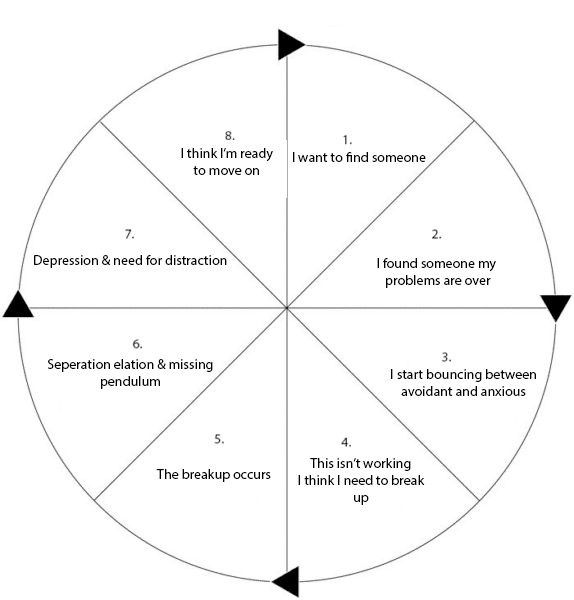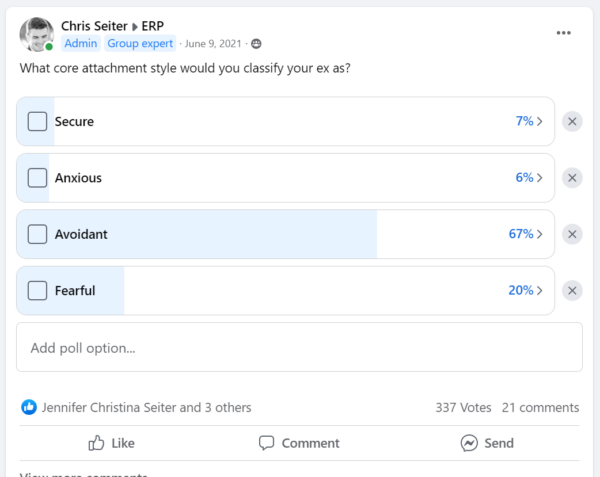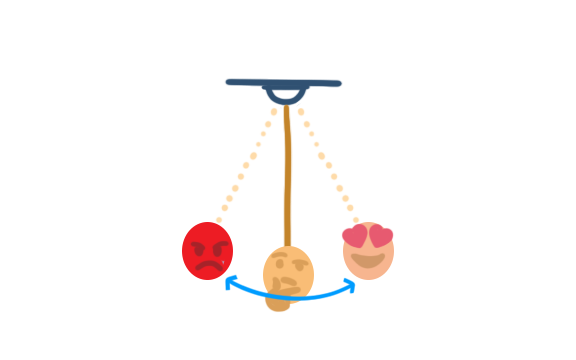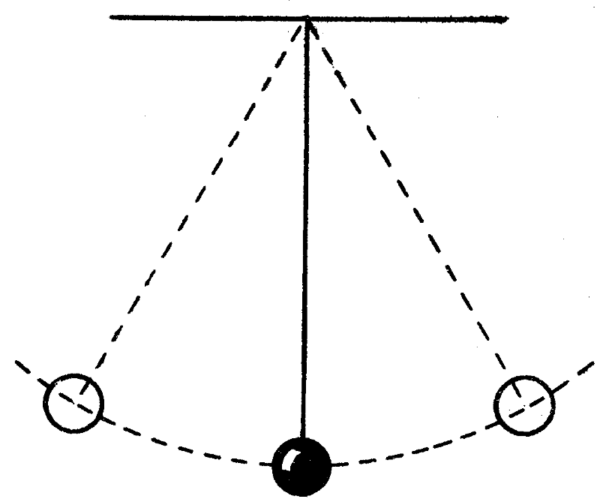Today we’re going to talk about the major signs that fearful avoidants have fallen in love with you.
One thing I want you to keep in mind as we go through this list is that with fearful avoidants there’s going to be this constant rotation back and forth between avoidant core wounds and anxious core wounds.

For those of you who won’t read the entirety of this article but want the cliff notes version here are the 18 signs we are going to be covering today,
- Emotional Intensity
- Intimacy in Moments
- Inconsistent Communication
- Invests in the Relationship
- Physical Affection
- Avoidant Attachment Actions
- Jealousy and Possessiveness
- Reflective and Thoughtful
- Responsive to Your Needs
- Seeking Reassurance
- Self-disclosure
- Avoidance of Conflict
- Longing Looks
- Romantic Gestures
- Fear of Loss
- Protective Nature
- Projecting Future Plans
- Personal Growth
But first things first, let’s talk about what a fearful avoidant actually is before we dive into these signs.

What Are Your Chances of Getting Your Ex Boyfriend Back?
Take the quizWhat A Fearful Avoidant Is
So, what exactly is a fearful avoidant attachment style?
Officially known as a disorganized attachment, this complex attachment pattern melds elements of both anxious and avoidant attachment styles. Essentially, someone with a fearful avoidant attachment style is constantly at war with themselves, torn between their anxious and avoidant tendencies.
To illustrate, I often describe to my clients that an individual with a fearful attachment style bears two core wounds.
- They are terrified of being abandoned romantically (The Anxious Core Wound)
- Yet equally dread losing their independence. (The Avoidant Core Wound)
Their responses to you or circumstances in their life can swing like a pendulum between these two core fears.

This is why they are sometimes misdiagnosed with having multiple personality disorder, although this is quite rare.
According to the Attachment Project, only about 7% of the population exhibit a fearful avoidant attachment style, making it a relatively rare occurrence. Consequently, if you suspect your partner possesses this attachment style, there is a 93% likelihood that this is not the case.
But let’s delve deeper into the intricate cycle that fearful avoidant individuals often find themselves ensnared in within relationships.
This website is renowned for its comprehensive analyses on breakups, investigating how different attachment styles cope with breakups and behave in relationships and when in love. I have even developed a graphic that encapsulates the experiences of each attachment style through the phases of a relationship, which I’ve coined “the death wheel”.
This is my Fearful Avoidant Death Wheel,
The “death wheel” delineates eight primary stages that characterize the tumultuous journey of the fearful avoidant attachment style in relationships.
- It initiates with a longing for love
- Followed by finding a partner and the ensuing belief that their troubles are over.
- However, this soon gives way to oscillation between avoidant and anxious core wounds
- Eventually culminating in a panic-induced conviction that a breakup is necessary.
- The breakup actually occurs.
- Post breakup, they experience swings of emotions from relief at regaining independence to regret and longing for their partner.
- This cycle often leads to depression and the search for distractions
- Before they convince themselves they are ready to move on. Tragically restarting the cycle anew.
You’ll notice a pervasive oscillation throughout the stages of the “death wheel”.
In relationships, they exhibit a flurry of anxious and avoidant behaviors, a pattern that persists even post breakup. They seem to embody chaos, trapped in an uncontrollable cycle dictated by their attachment style.
Through extensive research and observation, we’ve determined that a majority of individuals, especially during breakups, predominantly exhibit dismissive avoidant attachment styles, roughly around 70%.
Hence, it’s quite improbable that your partner has a fearful avoidant attachment style. However, to assist you in identifying the manifestations of love in someone with this attachment style, I have compiled a list of 18 clear signs.
Sign #1: Emotional Intensity:
Individuals with a fearful avoidant attachment style usually embody a whirlpool of emotions, oscillating between profound affection and guardedness.

What Are Your Chances of Getting Your Ex Boyfriend Back?
Take the quizWhen they love, they might dive deep, engulfed by a swirl of intense emotions that can sometimes be quite overwhelming, both for them and their partners.
This emotional depth, characterized by a strong empathic connection, passionate displays of affection, and a heightened sense of joy and sadness, can be a vivid testament to their love.
Although this emotional intensity can be both a blessing and a curse, it is undeniably a profound indicator of their capacity to love deeply and passionately.
Essentially the argument I’m making is really pay attention to the pendulum swing of emotions they’ll experience from anxious behavior to avoidant behaviors,

Sign #2: Intimacy in Moments
A fearful avoidant individual, despite their inherent apprehensions, will have moments of remarkable openness where they allow you a glimpse into their complex inner world.
During these moments, they might share intimate tales of their past, their dreams, fears, and aspirations, creating pockets of deep connection and understanding.
These fleeting moments of vulnerability can be seen as precious gems, revealing their genuine trust and affection for you. It’s during these rare instances that they let their love shine through, connecting with you on a level that transcends their fears and doubts, cementing the depth and authenticity of their love.
Sign #3: Inconsistent Communication
Communication patterns with a fearful avoidant partner can sometimes resemble a roller-coaster, fraught with highs and lows, illustrating their constant tug-of-war between desire and fear.
Once again, I’m going to point at the pendulum swing of emotions,
They might engage in deep, heartfelt conversations one moment and become distant the next.
This inconsistency, though perplexing, is often a manifestation of their inner turmoil, a sign of the deep love they harbor and their simultaneous fear of becoming too ensnared by it.
Their efforts to maintain a connection, despite their internal struggles, highlight their genuine affection and commitment to the relationship, as they navigate the complex labyrinth of their emotions.
Sign #4: They Invest In the Relationship:
Fearful avoidant individuals, when in love, show a significant degree of investment in the relationship.
Their investment might be manifested through:
- Dedicated time
- Thoughtful gestures
- Efforts to nurture and grow the bond.
Even though they might occasionally retract, their continuous efforts to come back and foster the relationship are a clear indication of their deep affection. This commitment is often coupled with a desire to create memorable experiences together and reflects their underlying love and the value they place on the relationship.
Sign #5: Physical Affection:
Physical affection often serves as a refuge for fearful avoidant individuals, a safe haven where they can express their love without the vulnerability of words.
- Their love might find expression through warm hugs
- Tender kisses
- Comforting cuddles
And offer a sense of closeness that sometimes words fail to convey.
Even in moments of emotional withdrawal, their physical affection remains a silent testimony to their deep affection, providing a sense of comfort and connection.
These gestures can be a beautiful dance, where their love finds a rhythmic expression, silently communicating the depths of their affection and forging bonds that transcend verbal communication.
Sign #6: Avoidant Attachment Actions:
We’ve already delved deep into the constant pendulum swing of emotions that fearful avoidants experience – a persistent vacillation between intense anxiety and pronounced avoidance within the relationship.
In this segment, we shall focus on understanding the underlying psychology driving their avoidant behavior.
Avoidant behavior in a fearful avoidant manifests as:
- Requests for personal space
- Noticeable withdrawal
- Or sudden, unexplained silences
- Even when they had previously been enthusiastic and engaged in planning future activities with you.
What’s happening at the core is an intricate dance of conflicting emotions.

What Are Your Chances of Getting Your Ex Boyfriend Back?
Take the quizWhen their anxious facet is activated, they are wholeheartedly invested in the relationship. However, this very commitment can incite fear as they confront the vulnerability that comes with deepening feelings. This, in turn, triggers their avoidant side, alarmed at the prospect of losing their cherished independence. Consequently, they find themselves caught in a whirlpool of fluctuating emotions, seemingly warm and affectionate one moment, and distant the next.
I should note, however, that not all instances of “hot and cold” behavior are indicative of deeper feelings or attachment concerns. It is crucial to ascertain that you are indeed involved with a fearful avoidant individual. In such cases, these fluctuations often signify their inner turmoil, stemming from a fear of over-commitment.
Sign #7: Jealousy and Possessiveness:
Fearful avoidant individuals may sometimes exhibit jealousy or possessiveness, stemming from their deep-seated anxieties and fear of loss.
This behavior, although it can be challenging to navigate, often illustrates the intensity of their feelings for you. Their possessiveness can be seen as a distorted expression of love, where their fear of abandonment overshadows their trust in the relationship.
Understanding that this behavior is rooted in fear, not a lack of affection, can help in deciphering the complex language of love that a fearful avoidant individual speaks, showcasing their raw, unfiltered affection and deep-seated desire to protect the bond they cherish.
Sign #8: Reflective and Thoughtful
Fearful avoidant individuals are often deeply reflective and thoughtful when it comes to their relationships.
Their love is characterized by a persistent internal dialogue, where they constantly evaluate and analyze the nuances of the relationship, in an effort to find a balance that accommodates their conflicting desires for intimacy and independence.
This reflective nature, although sometimes resulting in periods of withdrawal, also fosters a deeper understanding and appreciation for the relationship. Their thoughtfulness is a clear indicator of their deep affection, as they navigate the intricate dance of love with a keen awareness and sensitivity to both their needs and those of their partner.
Sign #9: Responsive to Your Needs
When not grappling with their fears, fearful avoidant individuals can be exceptionally responsive to your needs and desires.
Their periods of engagement are characterized by a deep-seated empathy and understanding, where they go out of their way to ensure your happiness and comfort.
Think of this as their anxious side coming to the forefront.
This responsiveness, though fluctuating, is a glowing testament to their love and affection. Their capacity to tune into your needs, to shower you with attention and care, illustrates the depth of their connection with you, showcasing a love that, though intermittently obscured by fear, shines through in moments of openness and connection.
Sign #10: Seeking Reassurance
The complex dynamics of fearful avoidant attachment often lead individuals to seek constant reassurance to calm their anxious hearts.
This continuous quest for affirmation, while sometimes exhausting, is a genuine expression of their deep-seated fears and the love that propels them to seek stability in the relationship.
Their need for reassurance reveals their vulnerability and their earnest desire to build a secure and loving connection. It’s a clear sign of their investment in the relationship, an indication of their deep affection, and their ongoing effort to nurture and sustain the bond they hold dear.
Sign #11: Self-disclosure:
For a fearful avoidant person, self-disclosure is akin to walking on a tightrope, balancing between the desire to connect deeply and the fear of being hurt.
Sharing personal and often vulnerable aspects of themselves is a brave step into the realm of deeper connection, a testimony to their trust and affection for you.
This gradual unveiling of their inner world, though sometimes hesitant, is a potent sign of their growing love and comfort in the relationship.
It reflects their willingness to overcome their fears, forging a path towards a deeper and more fulfilling bond, where love blossoms in the shared spaces of vulnerability and trust.
Sign #12: Avoidance of Conflict
Fearful avoidant individuals often adopt a conflict-avoidant stance, steering clear of disagreements to preserve the harmony of the relationship.
This avoidance, although sometimes resulting in suppressed feelings, is a reflection of their deep fear of loss and abandonment. Their reluctance to engage in conflict reveals a delicate attempt to protect the relationship from potential disruptions, showcasing a deep-seated desire to maintain the love and connection they cherish.
Understanding this dynamic can offer insight into their complex love language, where avoidance serves as a shield, safeguarding the precious bond they hold dear.
Sign #13: Longing Looks:
A fearful avoidant person’s affection often finds a silent yet poignant expression through non-verbal cues.
Their longing looks, filled with affection and a deep-seated desire for connection, can speak volumes, revealing the depths of their emotions.
These lingering, loving gazes are a window into their soul, offering glimpses of the love that sometimes finds it hard to articulate itself in words.
Recognizing these silent declarations can foster a deeper understanding and appreciation for the complex yet profound ways in which they express their love, providing moments of connection that transcend verbal communication.
Sign #14: Romantic Gestures:
Fearful avoidant individuals, in their moments of openness, often indulge in romantic gestures that can take your breath away.

What Are Your Chances of Getting Your Ex Boyfriend Back?
Take the quizThese actions, although sometimes sporadic, are their way of showcasing the deep affection they harbor for you. From thoughtful gifts to unexpected acts of kindness, these gestures are a beautiful expression of their love, an attempt to make you feel cherished and valued.
Despite their fears, these moments reveal a deep-seated desire to nurture and grow the relationship, illustrating their underlying hope and aspiration to forge a bond that transcends their fears and doubts.
Sign #15: Fear of Loss:
Recall the discussion in sign number six, where we highlighted the internal conflict fearful avoidants experience when they feel overly committed, prompting them to retreat into their avoidant tendencies.
Sign number 15, fear of loss, is essentially the other half of this emotional tug-of-war, the shadow to sign six.
Once again, remember the pendulum,

In this state of avoidance, they suddenly become hyper-aware of the potential loss, spiraling into a state of heightened anxiety and fear that they might lose you forever.
This shift is characterized by them swinging from a cold demeanor to an intensely warm approach, frequently seeking reassurance. It seems to you like a sudden, unexpected shift, often leaving you perplexed and wondering about their true feelings, as it may seem they were uninterested just a moment before.
Navigating a relationship with such individuals can be challenging due to their rapid mood fluctuations.
These shifts, although might appear erratic, are indicative of underlying childhood trauma and deeply entrenched fears, causing this continuous pendulum swing between their avoidant and anxious states.
Recognize this fear of loss as a trigger for their anxious core wound, which flares up amidst their conflicting emotional states.
Sign #16: Protective Nature
Individuals with a fearful avoidant attachment style often exhibit a pronounced protective nature towards their loved ones.
Their desire to shield you from harm or discomfort is a testament to their deep affection and the lengths they are willing to go to ensure your well-being.
This protective stance, though sometimes bordering on overprotectiveness, reveals a deep-seated love and commitment that goes beyond casual attachment.
Recognizing this protective nature can offer a glimpse into the profound and enduring love that fuels their desire to safeguard you and the relationship from potential harm.
Sign #17: Projecting Future Plans:
On Ex-Boyfriend Recovery, I often discuss how a positive sign of reconciliation with an ex is when they engage in “future pacing,” which involves envisioning and discussing potential future events or plans together.
This might take the form of casual mentions of future outings or revisiting fond memories with promises to recreate them in the near future.
However, with fearful avoidants, this future pacing comes with a caveat.
They often couple their forward-looking statements with expressions of fear, a mechanism to maintain control and prevent their avoidant side from activating.
Therefore, one piece of advice we frequently give our clients is to mirror the behavior of their fearful avoidant partner. When they retreat, give them the space they unconsciously seek; when they swing back towards their anxious state, offer them the reassurance they crave.
It is imperative, though, to maintain a balanced approach, demonstrating a secure attachment style instead of succumbing to their fluctuating dynamics. Your role isn’t to mend their internal conflicts, but to guide them towards experiencing a secure and stable bond, ensuring your attachment style remains steady, without drifting into fearful, anxious, or avoidant tendencies.
Sign #18: Personal Growth:
One of the most poignant signs of a fearful avoidant individual in love is their willingness to undertake personal growth or therapy to address their attachment issues.
This commitment to personal development is a powerful testimony to their love and dedication to the relationship. It reflects a sincere desire to evolve and grow, to build a healthier, more fulfilling bond.
This personal growth journey is a beacon of hope, a sign that love can indeed be a powerful motivator, propelling them to confront their fears and foster a relationship that not only survives but thrives amidst the complexities of their attachment style.




Fundi
September 21, 2023 at 9:04 pm
Very interesting. Would really love more information on this topic. It opened my mind.